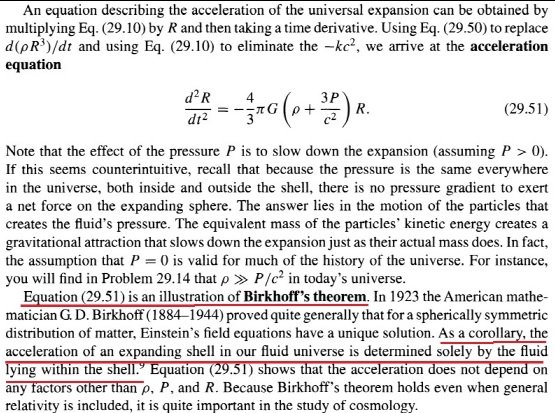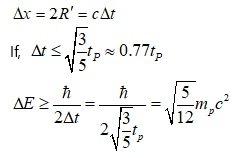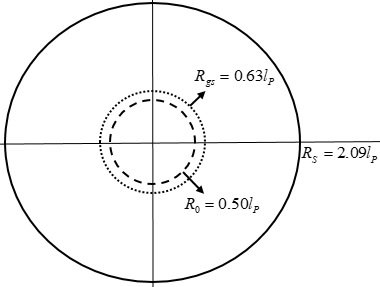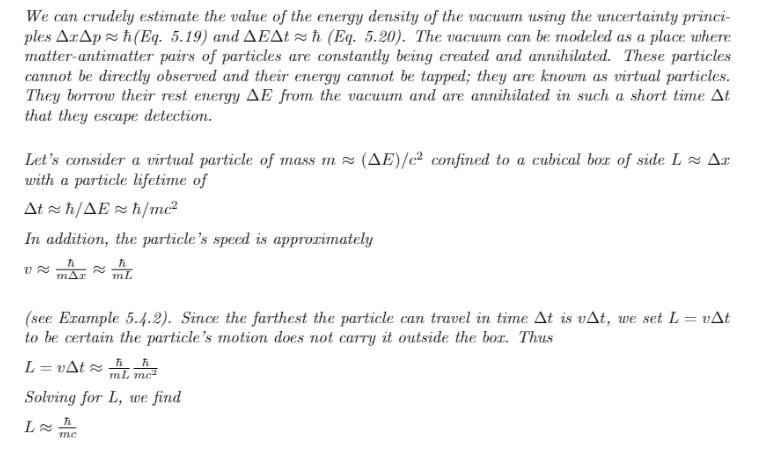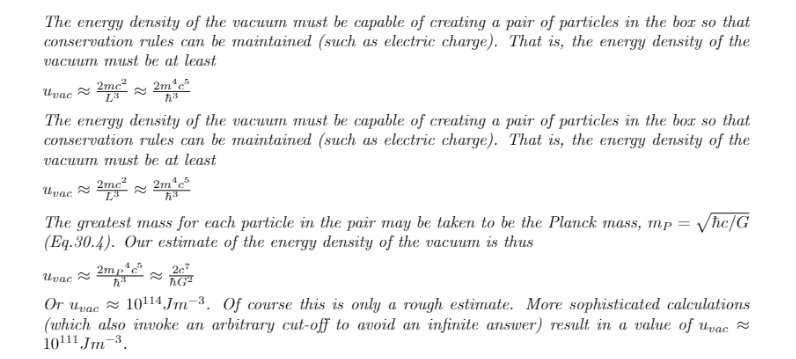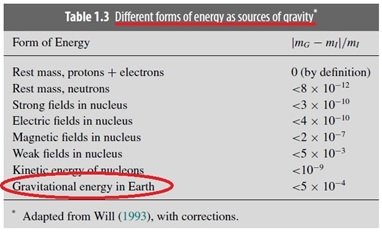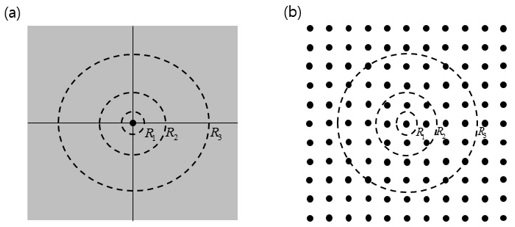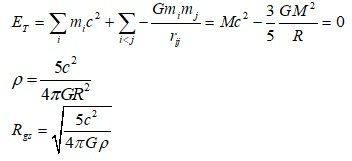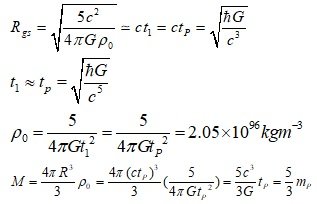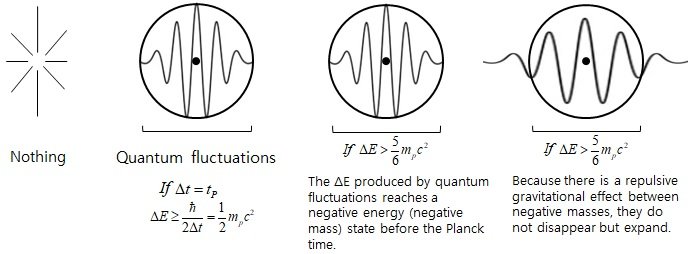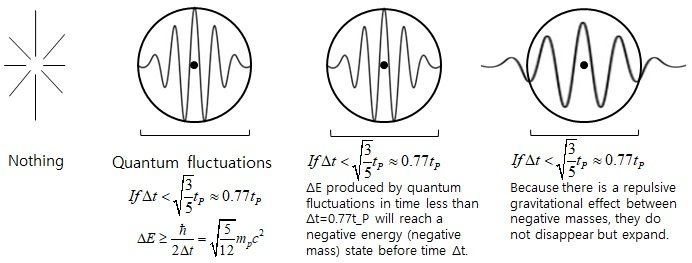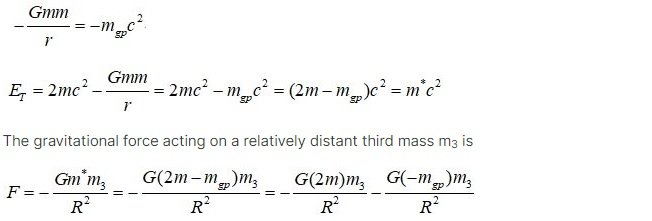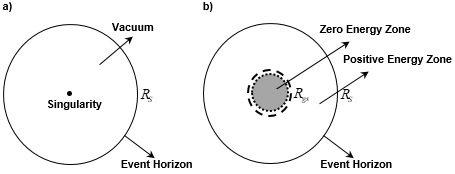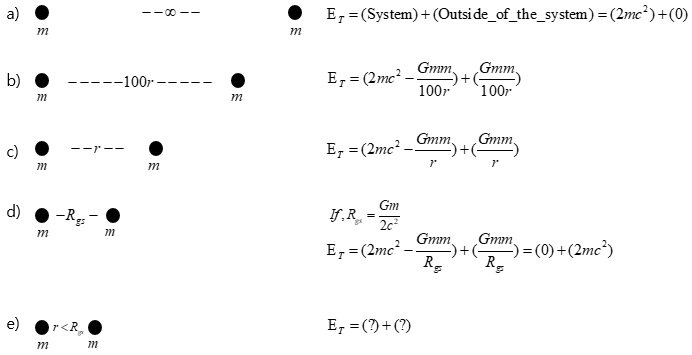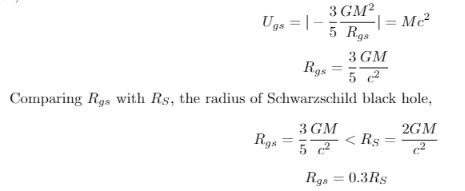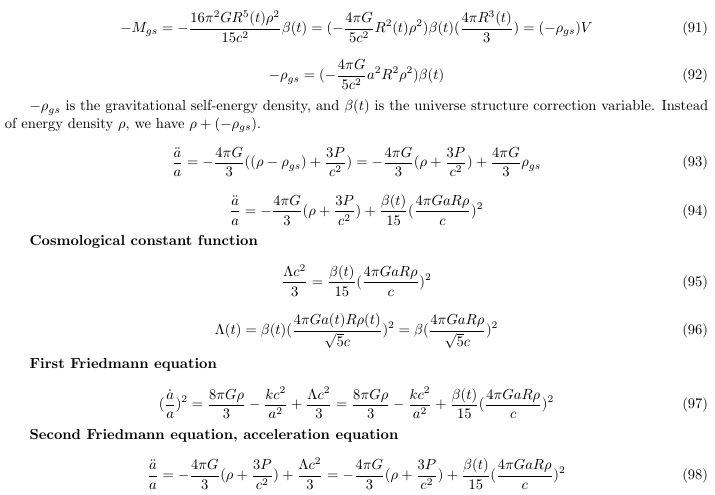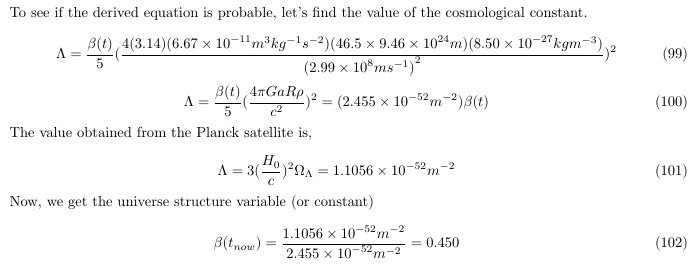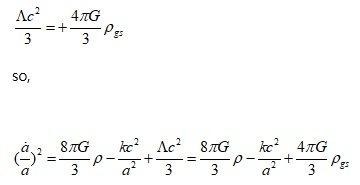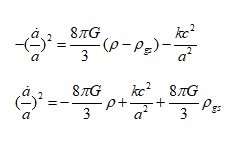-
Posts
107 -
Joined
-
Last visited
Content Type
Profiles
Forums
Events
Everything posted by icarus2
-
If the universe was nothing at the beginning, how did this state of nothing then create what is the universe? We don't yet know what the answer is. However, because it is an important issue, I am writing my personal opinion. Let's start with the following equation: A = A Before the universe was birthed, the concept of A did not even exist. This A is an concept created by intellectual creature called humanity, 13.8 billion years after the creation of the universe. Also, mathematical terms, including =, are concepts created by humans born after the birth of the universe. If we move "A" from the left side to the right side, 0 = A - A = 0 To make the idea clearer, let's express this a little differently. 0 = (+A) + (-A) = 0 This equation can be conceptually decomposed as "0", "0=(+A)+(-A)", "(+A)+(-A)=0", "0=0". 1)"0" : Something did not exist. Nothing state. 2)"0 = (+A) + (-A)" : (+A) and (-A) were born from "nothing". Or "nothing" has changed to +A and -A. Something state. 3)"(+A) + (-A) = 0" : The sum of (+A) and (-A) is still zero. From one perspective it's "something state", from another perspective it's still “nothing state”. 4)"0 = 0" At the beginning and end of the process, the state of “nothing” is maintained. 5) "B = 0 = (+A) + (-A) = 0" : The intelligent life form called humanity defines the "first nothing" as B. B may be total A, which is the sum of all A, or it may be a new notion. In other words, “nothing” can create something +A and something -A and still remain “nothing” state. And, the newly created +A and -A create new physical quantities and new changes. For example, in order for the newly created +A and -A to be preserved in space, a new relational equation such as a continuity equation must be created. ∂ρ/∂t + ∇·j=0 Let's look at how pair production occurs from photon (light). B = 0 = (+Q) + (-Q) = 0 The charge of a photon is zero. When photon do pair production, photon do not conserve charge by creating beings with zero charge, but by creating +Q and -Q to preserve zero. That is, in all cases, in all circumstances, in order to satisfy or maintain “nothing”, this equation of the form (+Q) + (-Q) = 0 must hold. This may be because "0" is not representative of all situations and is only a subset of (+Q) + (-Q) = 0. At the beginning and end of the process, the total charge is conserved, but in the middle process +Q and -Q are created. Due to the electric charge generated at this time, new concepts including electromagnetic fields and electromagnetic forces are needed. According to Emmy Noether's theorem, if a system has a certain symmetry, there is a corresponding conserved physical quantity. Therefore, symmetry and conservation laws are closely related. Conservation of spin, conservation of particle number, conservation of energy, conservation of momentum, conservation of angular momentum, conservation of flux... etc.. New concepts may be born from conservation laws like these. Let’s look at the birth process of energy. https://icarus2.quora.com/The-Birth-Mechanism-of-the-Universe-from-Nothing-and-New-Inflation-Mechanism E_T = 0 = (+E) + (-E) = Σmc^2 + Σ(-Gmm/r) = 0 “E_T = 0” represents “Nothing” state. Mass appears in “Σ(+mc^2)” stage, which suggests the state of “Something”. In other words, “Nothing” produces a negative energy of the same size as that of a positive mass energy and can produce “Something” while keeping the state of “Nothing” in the entire process (“E_T = 0” is kept both in the beginning of and in the end of the process). Another example is the case of gauge transformation for scalar potential Φ and vector potential A in electromagnetic fields. Φ --> Φ - ∂Λ/∂t A --> A + ∇Λ Maxwell equations of electromagnetism hold them in the same form for gauge transformation. After all, the existence of some symmetry or the invariance that the shape of a certain physical law must not change requires a gauge transformation, and this leads to the existence of new physical quantities (Λ, ∂Λ/∂t, ∇Λ) that did not exist in the beginning (Φ, A). This can be interpreted as requiring the birth of a new thing in order for the conserved physical quantity to be conserved and not change. The condition or state that should not change is what makes change. Why was the universe born? Why is there something rather than nothing? Why did the change happen? B = 0 = (+Q) + (-Q) = 0 E_T = 0 =(+E) + (-E) = Σmc^2 + Σ-Gmm/r = 0 ∂ρ/∂t + ∇·j=0 Φ --> Φ - ∂Λ/∂t A --> A + ∇Λ It changes, but does not change! It changes in order not to change! What does not change (B = 0) also creates changes in order not to change in various situations (Local, Global, phase transformation, translation, time translation, rotation transformation ...). This is because only the self (B) that does not want to change needs to be preserved. The change of the universe seems to have created a change by the nature of not changing. The universe created Something (space-time, quantum fluctuation, energy, mass, charge, spin, force, field, potential, conservation laws, continuity equation...) to preserve Nothing. By the way, as this something was born, another something was born, and the birth of something chained like this may still preserve the first "nothing", and in some cases, the first "nothing" itself may also have changed.
-
Mathematics began as human intellectual activity to describe phenomena that exist in nature and the universe. Therefore, mathematics and the universe have a very deep connection, and events that occur in the universe can generally be described through mathematics. However, in mathematics, if a proposition is true within a defined axiomatic system, then this proposition is true and has value. In other words, because mathematics reflects human intellectual activity, even things that are imaginary can become true. On the other hand, the universe is true to exist and has value. Therefore, mathematics and the universe are not completely the same thing.
-
Pressure, energy, and mass are all sources of gravity. Therefore, these terms enter the Friedmann equation and play the role of -(4πG/3)p, which is the gravitational effect. According to Birkhoff’s theorem, The first Friedmann equation without a cosmological constant is derived from general relativity, but there is also a form derived from the conservation of mechanical energy of Newtonian mechanics (dust model), and this is taught in major books. At this time, the terms entered are kinetic energy and gravitational potential energy. [math]\frac{1}{2}m{v^2}(t) - G\frac{{{M_r}m}}{{r(t)}} = E[/math] Therefore, the right-hand side term (8πG/3)ρ comes from the total mass M_r inside the shell. Friedmann's second equation without a cosmological constant is also derived from general relativity, but can also be derived from F=ma=-GMm/R^2. This also uses gravitational force. Because this is intuitive, if we look at this derivation process [math]ma = - \frac{{GMm}}{{{R^2}}}[/math] [math]m\frac{{{d^2}R(t)}}{{d{t^2}}} = - \frac{{GM(t)m}}{{R{{(t)}^2}}}[/math] [math]M(t) = \frac{{4\pi {R^3}(t)}}{3}\rho (t) = \frac{{4\pi {a^3}(t){R^3}}}{3}\rho (t)[/math] [math]m\frac{{{d^2}a(t)R}}{{d{t^2}}} = - Gm\frac{{\frac{{4\pi }}{3}{a^3}(t){R^3}\rho (t)}}{{{a^2}(t){R^2}}} = - Gm\frac{{4\pi }}{3}a(t)R\rho (t)[/math] [math]\frac{{\ddot a(t)}}{{a(t)}} = - \frac{{4\pi G}}{3}\rho (t)[/math] Adding pressure, we can create an acceleration equation. [math]\frac{{\ddot a}}{a} = - \frac{{4\pi G}}{3}(\rho + \frac{{3P}}{{{c^2}}})[/math] In other words, we can see that ρ(t) is the mass density inside the expanding shell, and the -(4πG/3)ρ term describes gravity or gravitational effects. It can be seen that the total mass M inside the shell is included in both Friedmann equations 1 and 2. This means that the equivalent mass of total energy is included. If matter and radiation have the same energy density ρ0, it is thought that they should be the same when entering the acceleration equation. In my opinion, We can put in the equivalent mass of the energy density of the radiation divided by c^2, and let the pressure of the radiation be 0, or since the rest mass of the radiation is 0, let the mass density be 0, and in the pressure term (1/3)ρ must be inserted. Photons are also included as relativistic particles. However, in this explanation, I tried to distinguish between relativistic particles that have rest mass and photons that do not have rest mass. For photons, which do you think is correct: 1ρ0 or 2ρ0 ?
-
Consider a situation where matter and radiation have the same energy density ρ_0. If we set c=1, mass density = energy density For matter, [math]{\rho _m} + 3P{}_m = {\rho _m} + 3(0) = {\rho _m} = {\rho _0}[/math] For radiation (photon), [math]{\rho _r} + 3P{}_r = {\rho _r} + 3(\frac{1}{3}{\rho _r}) = 2{\rho _r} = 2{\rho _0}[/math] Now if we think about the physical meaning of the two cases, This means that if matter and radiation have the same energy density ρ_0, the gravitational effect of the radiation is twice that of the matter. If photon and matter have the same energy density, does the photon exert twice the gravitational force (or effect) than the material exerts? Is this true? In my opinion, In the case of photon, it seems wrong to include both density in the (mass) density term and pressure term.
-
I think I didn't phrase the question appropriately. [math]\frac{1}{R}(\frac{{{d^2}R}}{{d{t^2}}}) = - \frac{{4\pi G}}{3}({\rho _m} + {\rho _r} + {\rho _\Lambda } + \frac{{3({P_m} + {P_r} + {P_\Lambda })}}{{{c^2}}})[/math] [math]\rho + \frac{{3P}}{{{c^2}}} = ({\rho _m} + \frac{{3P{}_m}}{{{c^2}}}) + ({\rho _r} + \frac{{3P{}_r}}{{{c^2}}}) + ({\rho _\Lambda } + \frac{{3P{}_\Lambda }}{{{c^2}}})[/math] In this question the first and third terms are not of interest. What happens if you summarize(Energy density of photon ρ) the second term? When the energy density of a photon is ρ, I am curious as to whether its gravitational effect in the acceleration equation is 1ρ or 2ρ. *When considering the dimension, it must be divided by c^2, but this is not an important issue. [math]{\rho _r} + \frac{{3P{}_r}}{{{c^2}}} = [/math]
-
Gravitational effect and pressure of photons in Friedmann equation? [math] \frac{1}{R}(\frac{{{d^2}R}}{{d{t^2}}}) = - \frac{{4\pi G}}{3}({\rho _m} + {\rho _r} + {\rho _\Lambda } + \frac{{3({P_m} + {P_r} + {P_\Lambda })}}{{{c^2}}}) [/math] ρ is the unit of mass density. Pressure of matter : P=0 Pressure of radiation : P=(1/3)ρc^2 Regarding the source of pressure, there are the following expressions in major books: In special relativity, [math]{E^2} = {({m_0}{c^2})^2} + {(pc)^2}[/math] For matter, [math]{E^2} = {({m_0}{c^2})^2}[/math] For, relativistic particle, [math]{E^2} = {({m_0}{c^2})^2} + {(pc)^2}[/math] For, radiation or photon, [math]{E^2} = {(pc)^2}[/math] So, here's the question. For a relativistic particle with rest mass it would be: [math]{E^2} = {({m_0}{c^2})^2} + {(pc)^2}[/math] In the case of relativistic particles, there is a pressure component due to kinetic energy or momentum, and this value cannot be ignored compared to mass energy. [math]\frac{1}{R}(\frac{{{d^2}R}}{{d{t^2}}}) = - \frac{{4\pi G}}{3}({\rho _{{\rm{relativistic particle}}}} + \frac{{3{P_{{\rm{relativistic particle}}}}}}{{{c^2}}}) = - \frac{{4\pi G}}{3}({\rho _{{\rm{rel - par}}}} + \frac{{3(\frac{1}{3}{\rho _{{\rm{rel - par}}}}{c^2})}}{{{c^2}}}) = - \frac{{4\pi G}}{3}(2{\rho _{{\rm{rel - par}}}})[/math] [math]\frac{1}{R}(\frac{{{d^2}R}}{{d{t^2}}}) = - \frac{{4\pi G}}{3}(2{\rho _{{\rm{rel - par}}}}) = - \frac{{4\pi G}}{3}(\frac{{2{\rho _{{\rm{rel - par}}}}{c^2}}}{{{c^2}}})[/math] When the energy density of matter is ρ, in the Friedmann equation, matter generates the gravitational effect of ρ. When the energy density of a relativistic particle is ρ, in the Friedmann equation, the relativistic particle generates a gravitational effect of 2ρ. But what about photons, which are not relativistic particles? Which expression is correct for photons that have no rest mass? 1) [math]\frac{1}{R}(\frac{{{d^2}R}}{{d{t^2}}}) = - \frac{{4\pi G}}{3}({\rho _{rad}} + \frac{{3(\frac{1}{3}{\rho _{rad}}{c^2})}}{{{c^2}}}) = - \frac{{4\pi G}}{3}(2{\rho _{{\rm{rad}}}}) = - \frac{{4\pi G}}{3}(\frac{{2{\rho _{{\rm{rad}}}}{c^2}}}{{{c^2}}})[/math] Considering radiation(When limited to photons) with energy density ρ, it generates a gravitational effect equal to twice the energy density : 2ρ ? 2) [math]\frac{1}{R}(\frac{{{d^2}R}}{{d{t^2}}}) = - \frac{{4\pi G}}{3}({\rho _{{\rm{radiation}}}} + \frac{{3{P_{{\rm{radition}}}}}}{{{c^2}}}) = - \frac{{4\pi G}}{3}(0 + \frac{{3(\frac{1}{3}{\rho _{rad}}{c^2})}}{{{c^2}}}) = - \frac{{4\pi G}}{3}({\rho _{{\rm{rad}}}}) = - \frac{{4\pi G}}{3}(\frac{{{\rho _{{\rm{rad}}}}{c^2}}}{{{c^2}}})[/math] Considering radiation(When limited to photons) with energy density ρ, it generates a gravitational effect equal to 1 times the energy density : 1ρ ? 1) Is the expression correct? 2) Is the expression correct?
-
In the post just above, Even if there was no energy before the Big Bang, enormous amounts of energy can be created due to the uncertainty principle. In a region smaller than the size of an atomic nucleus, the total mass-energy that exists in the observable universe can be created. In the early universe, when only positive mass energy is considered, the mass energy value appears to be a very large positive energy, but when negative gravitational potential energy is also considered, the total energy can be zero and even negative energy. Considering not only mass energy but also gravitational potential energy, the total energy of the system is According to the uncertainty principle, during Planck time, energy fluctuations of more than (1/2)m_pc^2 are possible. However, let us consider that an energy of ΔE=(5/6)m_pc^2, slightly larger than the minimum value, was born. 1) If, Δt=t_p, ΔE=(5/6)m_pc^2, The total energy of the system is 0. In other words, a mechanism that generates enormous mass (or energy) while maintaining a Zero Energy State is possible. 2) If, Δt=(3/5)^(1/2)t_p, ΔE≥(5/12)^(1/2)m_pc^2, The total energy of the system is 0. In other words, a mechanism that generates enormous mass (or energy) while maintaining a Zero Energy State is possible. This is not to say that the total energy of the observable universe is zero. This suggests that enormous mass energy can be created from a zero energy state in the early stages of the universe. In this way (If we are limited to what is explained in this post~), the total energy of one quantum fluctuation is zero energy. Since individual quantum fluctuations are born in a zero energy state, and as time passes, the range of gravitational interaction expands, when surrounding quantum fluctuations come within the range of gravitational interaction, accelerated expansion occurs by this method. This method uses the minimum value of energy fluctuations. On the other hand, at energies greater than the minimum, expansion can occur even from a single quantum fluctuation. Through this model, we can simultaneously solve the problem of the origin of enormous energy and the problem of accelerated expansion in the early stages of the universe.
-
A combined model of the uncertainty principle and gravitational potential energy provides an explanation for how the universe was born and expanded in a dense state. [math] \Delta E\Delta t \ge \frac{\hbar }{2}[/math] From the energy-time uncertainty principle, If, [math]\Delta t \approx {t_P} = 5.391 \times {10^{ - 44}}s[/math] [math]\Delta E \ge \frac{\hbar }{{2\Delta t}} = \frac{\hbar }{{2{t_P}}} = \frac{1}{2}m{}_P{c^2}[/math] Δx=ct_p=2R’ : Since Δx corresponds to the diameter of the mass distribution Assuming a spherical mass distribution and calculating the average mass density (minimum value), [math]\frac{1}{2}{m_P} = \frac{{4\pi {{R'}^3}}}{3}{\rho _0} = \frac{{4\pi {{(\frac{{c{t_P}}}{2})}^3}}}{3}{\rho _0}[/math] [math]{\rho _0} = \frac{3}{\pi }\frac{{{m_P}}}{{{l_P}^3}} = \frac{3}{\pi }{\rho _P} \simeq 4.924 \times {10^{96}}kg{m^{ - 3}}[/math] It can be seen that it is extremely dense. In other words, the quantum fluctuation that occurred during the Planck time create energy with an extremely high density. The total mass of the observable universe is approximately 3.03x10^54 kg (used to ρ_c=8.5x10^-27 kg/m^3), and the size of the region in which this mass is distributed with the initial density ρ_0 is R_obs-universe (ρ=ρ_0) = 5.28x10^-15 [m] This value is approximately the size of an atomic nucleus. Not all models can account for the high dense state of the early universe. Also, not all models can provide repulsion or expansion to overcome the very strong gravity in this high-density state. So it's a decent result. [ Verifiability ] As a key logic to the argument of this paper, gravitational potential energy appears, and the point where the magnitude of the negative gravitational potential energy equals the positive mass energy becomes an inflection point, suggesting that the accelerated expansion period is entered. [math]{R_{gs}} = \sqrt {\frac{{5{c^2}}}{{4\pi G{\rho _0}}}} [/math] Since we can let R_gs be approximately ct(for a space with uniform energy (mass) density) or cΔt/2(with the uncertainty principle applied, if the energy (mass) distribution enters an accelerated expansion within Δt), there is a strong constraint equation between the density and the time the universe entered accelerated expansion. Therefore, it is possible to verify the model through this. It is necessary to create an early universe accelerating expansion model to which the ideas in this paper are applied. When such precise models come out, there will be more factors that can verify the model's accuracy.
-
*Revision Mass energy is of the form \(E=Mc^{2}\) and remains constant. On the other hand, the gravitational potential energy is of the form \({U_{gs}} = - \frac{3}{5}\frac{{G{M^2}}}{R}\), and the absolute value decreases as R increases. Therefore, when the mass distribution expands, only the absolute value of the negative gravitational potential energy term decreases, so the system switches to the positive mass state after \(R=R_{gs}\). The reduced gravitational potential energy will be converted into kinetic energy. For example, if the mass in the system is constant and R (R is the radius of the mass distribution) doubles from \(R_0\) to \(2R_0\), it can be seen that the absolute value of the gravitational self-energy is reduced by a factor of \(\frac{1}{2}\).
-
3.6. The Vacuum Catastrophe Problem or Cosmological Constant Problem The vacuum catastrophe problem or the cosmological constant problem is a problem in which there is a large difference between the theoretical prediction of vacuum energy proposed by quantum field theory and the observed value. It is known that there is a difference of about 10^120 between theoretical predictions and observed values. Strictly speaking, the vacuum energy model is only one of the dark energy models, so the observed (or estimated from observed results) dark energy density may not be the density of vacuum energy. Therefore, the actual vacuum energy density can be the dark energy density, or zero, or negative. However, if the density of vacuum energy is greater than the dark energy density, it will have a larger effect than the dark energy term, so it can be excluded by observational results. Therefore, the upper limit of the observed vacuum energy density is approximately the dark energy density, and there is still a difference of more than 10^120 times between the theoretical prediction value and the actual vacuum energy density value. First, looking at the claims of the vacuum energy model, Since there is energy ΔE or u_{vac}, which is one of the sources of gravity, and there is time Δt for gravity to propagate, the gravitational self-energy must also be considered in this problem. So, to look at the mainstream estimates in terms of my model, let's do some calculations. We have an equation for calculating the total gravitational potential energy in the case of a spherical, uniform distribution. This value is called the gravitational self-energy. In the vacuum energy model, calculations were performed as a regular hexahedron with one side L. If we consider a spherical space inside a regular hexahedron, the value of the vacuum energy density will be the same in this case. Since there is an expression for gravitational self-energy already calculated for spherical space, to utilize it, let's consider a spherical energy (mass) distribution with \(R = \frac{L}{2}\). According to the mass-energy equivalence principle, it is possible to define the equivalent mass (m = E/c^2) for all energies. Therefore, in this paper, the terms equivalent mass energy or mass energy or mass are sometimes used for objects with positive energy. 3.6.1. Vacuum energy in space R = L/2 [math]{E_{vac}} = \frac{{4\pi {R^3}}}{3}{u_{vac}} = \frac{{4\pi {{(\frac{L}{2})}^3}}}{3}(\frac{{2{c^7}}}{{\hbar {G^2}}}) = \frac{{4\pi {{(\frac{\hbar }{{2{m_P}c}})}^3}}}{3}(\frac{{2{c^7}}}{{\hbar {G^2}}}) = \frac{\pi }{3}{m_P}{c^2}[/math] [math]{E_{vac}} = \frac{\pi }{3}{m_P}{c^2} \simeq + 1.047{m_P}{c^2}[/math] 3.6.2. The gravitational potential energy of the vacuum energy of space R = L/2 [math]{U_{gs}} = - \frac{3}{5}\frac{{G{M^2}}}{R} = - \frac{3}{5}\frac{{G{{(\frac{\pi }{3}{m_P})}^2}}}{{\frac{L}{2}}} = - \frac{3}{5}\frac{{G{{(\frac{\pi }{3}{m_P})}^2}}}{{(\frac{\hbar }{{{2m_P}c}})}} = - \frac{{2{\pi ^2}}}{{15}}{m_P}{c^2}[/math] [math]{U_{gs}} = - \frac{{2{\pi ^2}}}{{15}}{m_P}{c^2} \simeq - 1.316{m_P}{c^2}[/math] 3.6.3. The event horizon created by vacuum energy \({E_{vac}} = \frac{\pi }{3}{m_P}{c^2}\) [math]{R_S} = \frac{{2GM}}{{{c^2}}} = \frac{{2G(\frac{\pi }{3}{m_P})}}{{{c^2}}} = \frac{{2\pi }}{3}{l_P} \simeq 2.094{l_P}[/math] 3.6.4. The radius R_gs at which the magnitudes of positive mass energy and negative gravitational potential energy are equal [math]|\frac{{{U_{gs}}}}{{{E_{vac}}}}| = |\frac{{ - \frac{3}{5}\frac{{G{{(\frac{\pi }{3}{m_P})}^2}}}{R}}}{{\frac{\pi }{3}{m_P}{c^2}}}| = | \frac{{\frac{\pi }{5}\frac{{G{m_P}}}{{{c^2}}}}}{R}| = 1 [/math] [math] {R_{gs}} = \frac{\pi }{5}{l_P} = 0.628{l_P} [/math] 3.6.5. Physical meaning of calculated R values [math] {E_T}(t = \Delta t) = {E_{vac}} + {U_{gs}} = \frac{\pi }{3}{m_P}{c^2} - \frac{{2{\pi ^2}}}{{15}}{m_P}{c^2} \simeq - 0.269{m_P}{c^2} < 0 [/math] Initially, since the negative gravitational potential energy is greater than the positive mass energy, the mass distribution at \({R_0} = \frac{L}{2}\) will expand. If there is no additional mass influx (or if mass is held constant), when the expanding mass distribution passes \(R_{gs}\), the negative gravitational potential energy equals the positive mass energy. When the mass distribution becomes larger than R_gs, since the positive mass energy is greater than the negative gravitational potential energy, the system switches to the positive mass state, and thus the situation in which the attractive force acts. Thus, the mass distribution will contract back to R_gs. Mass energy is of the form E=Mc^2 and remains constant. On the other hand, the gravitational potential energy is of the form \({U_{gs}} = - \frac{3}{5}\frac{{G{M^2}}}{R}\), which decreases as R increases. Therefore, when the mass distribution expands, only the negative gravitational potential energy term decreases, so the system switches to the positive mass state after R=R_gs. The reduced gravitational potential energy will be converted into kinetic energy. For example, if the mass in the system is constant and R (R is the radius of the mass distribution) doubles from R_0 to 2R_0, it can be seen that the gravitational self-energy is reduced by a factor of 1/2. [math] {U_{gs}}(R = {R_0}) = - \frac{3}{5}\frac{{G{M^2}}}{{{R_0}}} [/math] [math] {U_{gs}}(R = 2{R_0}) = - \frac{3}{5}\frac{{G{M^2}}}{{2{R_0}}} = \frac{1}{2}{U_{gs}}(R = {R_0}) [/math] R < R_gs : system is in negative energy (mass) state. Since the repulsive force component is greater than the attractive force component, the mass distribution expands. R > R_gs : The system is in a positive energy (mass) state. Since the attractive force component is greater than the repulsive force component, the mass distribution undergoes deceleration expansion and contraction. Therefore, the mass distribution becomes stable at R=R_gs while oscillating around R=R_gs. The point where R=R_gs is the point where the total energy of the system is zero. One of the important characteristics is that it vibrates (repeating acceleration and deceleration expansion) based on R=R_gs, and finally stabilizes at R=R_gs. This is because the R=R_gs point is the point where the positive and negative energy components are equal, and the total energy of the system is zero. Although we are analyzing the process in detail, the time interval between these events is approximately t_P ~ 10^{-44}s. As a rough estimate, if there is no additional mass density generation within the 1l_P(Planck length, approximately 2(0.50(l_P))) range, the mass distribution will converge to R_gs where the positive mass energy equals the negative gravitational potential energy. As a result, the mass distribution returns to the zero-energy state because the magnitudes of the positive mass energy and the negative gravitational self-energy in R_gs are equal. Also, since the event horizon R_S=2.09(l_P) formed by the mass distribution of R_0 is greater than R_gs=0.63(l_P), the mass distribution exists inside the event horizon. Therefore, the mass distribution does not escape the event horizon, converges to R_gs, and finally returns to nothing. And, as a problem of consideration, when a stellar black hole forms, the space-time outside the black hole is affected and curved during the process of forming the black hole. By the way, after forming the black hole, if the location of the mass distribution changes inside the black hole, does this also affect the space-time outside the black hole? It is estimated that gravity due to changes in the distribution of mass inside the black hole will not be able to escape the black hole. Even when gravity due to changes in the mass distribution inside the black hole affects the geometry of space-time outside the black hole, the effect is zero or very close to zero because of the gravitational properties of negative gravitational potential energy and positive mass energy described above. As in previous theoretical calculations, if the vacuum had an enormous energy of \({u_{vac}} \approx {10^{111}} \sim {10^{114}}J{m^{ - 3}}\), it should be observable around us. However, we are not detecting the presence of these enormous energies from the vacuum. Even if quantum fluctuations occur in vacuum according to existing theoretical assumptions, since ΔE and Δt exist, their own gravitational interactions must also be taken into account. Therefore, considering the gravitational self-energy, the vacuum energy density is likely to be zero, unless the frequency of quantum fluctuations in the vacuum is extremely high. If the frequency of occurrence of quantum fluctuations is less than approximately 1 within the range of radius l_P during the 5t_P(rough estimate), it can be estimated that the total energy of the quantum fluctuations produced will be in the zero energy. For example, as a rough estimate, let's assume that 1 quantum fluctuation occurs within a radius of 1(l_P, Planck length ) in 100(t_P) time. Even in this case, it suggests a return to the zero energy state by the above mechanism.This is the case assuming an enormous number of quantum fluctuations. This situation corresponds to the assumption of approximately 10^147 ( 100{t_P} ~10^{-42}s, 2(1{l_P}) ~ 10^{-35}m, Volume ~ 10^{-105}m^3) quantum fluctuations per second, in a space of 1m^3. Thus, vacuum energy is not a source of dark energy. If the problem is a simple situation that cannot explain the difference in density of 10^120, the possibility remains that the difference in density can be explained by some mechanism at some point in the future. The real problem with vacuum energy model is, First, that positive energy density (positive inertial mass density) and negative pressure are logically contradictory because the source of pressure is momentum or kinetic energy. Second, even in the case of light with the greatest momentum or kinetic energy component relative to the total energy, the pressure is \(P = \frac{1}{3}\rho \). The claims of the vacuum energy model require a being with a momentum or kinetic energy three times (\({P_\Lambda } = - {\rho _\Lambda } = - 3(\frac{1}{3}{\rho _\Lambda })\)) greater than that of light. Third, it is a problem related to the logic of \({\rho _\Lambda } + 3{P_\Lambda } = {\rho _\Lambda } + 3( - {\rho _\Lambda }) = - 2{\rho _\Lambda }\). Mass density ρ and pressure P are properties that an object has. Also, mass density ρ and pressure P are the sources of gravity. However, even if the volume does not expand or contract and maintains a constant size, it means that the gravitational force of \({\rho _\Lambda } + 3{P_\Lambda } = - 2{\rho _\Lambda }\) is applied. That is, it suggests that the object (or energy density) has a gravitational force with a negative mass density of -2ρ_Λ. This is different from a vacuum, which we think has a positive energy density +ρ_Λ. Fourth, it also seems that there is a problem in applying dU = - PdV to vacuum energy. And, there are models that are 10^120 more accurate than the vacuum energy model. The Birth Mechanism of the Universe from Nothing and New Inflation Mechanism https://www.researchgate.net/publication/371951438
-
Inline math is displayed in the flow of a sentence \(m{c^2}\). hm [math] y = \int f(x) dx [/math] Inline brackets: \( y = x^2 \) Inline brackets: \[ y = x^2 \]
-
First of all, thank you for your sincere advice. Actually I lack knowledge and skills. My research is a personal hobby. It is true that I need to study more to make my hobby more meaningful. However, on the other hand, should I have to study hard to enjoy my hobby? Even if I study, there is still a high entry barrier, and I am not sure if I will overcome the entry barrier. As for my current interests, I have some interest in publishing my research on arXiv or mainstream journals. arXiv requires endorsements from other scientists. Even with the endorsement of another scientist, the administrator will delete it arbitrarily. I've had that process a few times, so, now I don't even try. I think this paper contains very cool ideas and is worthwhile. By any chance, do you have any intention of summarizing the content of my thesis in half and submitting it to a journal as a corresponding author? I can also solve the vacuum catastrophe problem! However, the result may not be what you expect. However, it is a solution that did not exist before, and it will be a pioneer of a new path. Vacuum catastrophe problem has not yet been added to this thesis. I will update this post with that in a week or less. Once again, thank you for your goodwill.
-
That part introduces beings with energy just to explain the characteristics of gravitational potential energy. The situation in which universe exists after birth from zero energy is the content of chapter 4.1 ~ 4.2. Of course, it is not completely nothing because it assumes the existence of principles of physics such as the uncertainty principle, but the term "nothing" is sometimes used in that it starts from zero energy.
-
The phrase I wrote is this. In Figure 1, if the mass-energy within the radius R_1 interacted gravitationally at t_1 (an arbitrary early time), the mass-energy within the radius R_2 will interact gravitationally at a later time t_2. As the universe ages, the mass-energy involved in gravitational interactions changes, resulting in changes in the energy composition of the universe. The total energy $E_{T}$ of the system is [math]{E_T} = \sum\limits_i {{m_i}{c^2}} + \sum\limits_{i < j} { - \frac{{G{m_i}{m_j}}}{{{r_{ij}}}}} = M{c^2} - \frac{3}{5}\frac{{G{M^2}}}{R}[/math] And, it is a matter of interpreting mass-energy as a being with mass or energy. It's just a summary of a 24-pages thesis. And, in the introduction of the thesis, there are the following passages: In addition, although there are electric charges, spins, and various physical quantities, it is necessary to analyze the problem of expanding the universe due to gravitational interactions because the object will be a being with at least energy (mass) even in various situations. I'm sorry for you too. I didn't understand what you meant. I misunderstood this sentence(As mentioned energy is the property describing the ability to perform work. It isn't something that exists on its own.) you wrote. I am so sorry. The total energy E_{T} of the system And, mass-energy means a being with mass or energy.
-
I think this claim( It isn't something that exists on its own.) about potential energy is false. Potential energy should be treated as real energy, not virtual energy. Potential energy must have a specific value under specific circumstances. 1. In the calculation of potential energy, not only the calculation through the amount of change is successful. Calculations with own values(I don't know what to choose as the right word. own value?) also succeed. In other words, even if the calculation through the change is successful, it does not guarantee that it is correct. U=mgh or U=-GMm/r 2. Looking at the electromagnetic potential energy similar to the gravitational potential energy, + + or - - : When the same kind of charge exists, [math]{U_{ + + }} = + \frac{{k{q_1}{q_2}}}{r} + {c_1}[/math] + - : When charges of different species exist, [math]{U_{ + - }} = - \frac{{k{q_1}{q_2}}}{r} + {c_2}[/math] 1)The situation where +Q+Q and +Q-Q exist seems to be a symmetrical situation, should c1, c2 exist? 2)Let's assume that the constants are the same as c1=c2, + + : When same kind charges exist, U=+kq1q2/r +c1 + - : When charges of different kinds exist, U=-kq1q2/r + c1 Does this asymmetry look right? 3. In elementary particle physics, invariant mass includes either binding energy or potential energy, depending on how the system is defined. It is well known that when proton-neutrons make up a nucleus, they have less mass than they do in their free state. Since these protons and neutrons do not change their mass in the coordinate system of their center of mass, they are rest mass and invariant mass in this situation. However, when they form one nucleon, the mass decreases by the difference in binding energy. In other words, the constant mass of one nucleon has a negative binding energy. Now there's the matter of combining nucleons with other nucleons, then the individual nucleons have an invariant mass. This is because, in the coupling problem of two nucleons, individual nucleons are assumed to be invariant in the coordinate system of the center of mass of the individual nucleons. I think we need to think about the meaning of the fact that the binding energy is included in the rest mass of the composite particle. In composite particles, binding energy is also a component of invariant mass. Should we treat these objects as objects that do not have any own value (fixed value), as objects that have values only when changes occur without substance? Since almost all problems related to potential energy are problems of calculating the amount of change, the idea that the amount of change is important in potential energy and that only the amount of change has meaning has been established. Even if the calculation through amount of change is successful, it does not guarantee that it does not have any energy value. The reason is that even if the energy has an own value, it still succeeds in explaining the problem by calculating the change. U=mgh, U=-GMm/r : Both give the correct values in the change calculation problem. 4. Regarding gravitational potential energy, some physicists think differently than you. I've talked a lot about potential energy, but the notion acquired by education is strong, and I'm not capable enough to break it. So, a little bit of other people's opinions. 1) Alan Guth said The energy of a gravitational field is negative! The positive energy of the false vacuum was compensated by the negative energy of gravity. 2) Stephen Hawking also said The matter in the universe is made out of positive energy. However, the matter is all attracting itself by gravity. Two pieces of matter that are close to each other have less energy than the same two pieces a long way apart, because you have to expend energy to separate them against the gravitational force that is pulling them together. Thus, in a sense, the gravitational field has negative energy. In the case of a universe that is approximately uniform in space, one can show that this negative gravitational energy exactly cancels the positive energy represented by the matter. So the total energy of the universe is zero. 3) Gravitation and Spacetime (Book) : 25~29P Different forms of energy as source of gravity : Gravitational energy in Earth If we want to discover whether gravity gravitates, we must examine the behavior of large masses, of planetary size, with significant and calculable amounts of gravitational self-energy. Treating the Earth as a continuous, classical mass distribution (with no gravitational self-energy in the elementary, subatomic particles), we find that its gravitational self-energy is about 4.6×10^−10 times its rest-mass energy. The gravitational self-energy of the Moon is smaller, only about 0.2 × 10^−10 times its rest-mass energy. 4) Explanation of GRAVITY PROBE B team https://einstein.stanford.edu/content/relativity/a11278.html Do gravitational fields produce their own gravity? Yes. A gravitational field contains energy just like electromagnetic fields do. This energy also produces its own gravity, and this means that unlike all other fields, gravity can interact with itself and is not 'neutral'. The energy locked up in the gravitational field of the earth is about equal to the mass of Mount Everest, so that for most applications, you do not have to worry about this 'self-interaction' of gravity when you calculate how other bodies move in the earth's gravitational field. i,j, are subscripts used a lot in physics, and are not subscripts used only in the case of Euler coordinates. And, in the symbol of summation, there is also an explanation of gravitational potential energy. So, I don't think anyone interprets it as Euler coordinates. [math] \sum { - \frac{{G{m_i}{m_j}}}{{{r_{ij}}}}} [/math] When obtaining the potential energy of the mass system, the potential terms of all pairs are summed using the summation symbol. Then, since overlapping terms occur, i<j or a<b is used. It is used to avoid overlapping ordered pairs in ordered pairs. In the major books I used, the notation "m_0" was always used to indicate rest mass. The same notation can be seen in the display of the wiki you linked to. When I use a rest mass, I use the notation m_0. The "m" I used is total mass, or equivalent mass. [math]{E^2} = {({m_0}{c^2})^2} + {(pc)^2}[/math]
-
One of humanity's ultimate questions is "How did the universe come into existence?" Since energy is one of the most fundamental physical quantities in physics, and particles and the like can be created from this energy, this question is "How did energy come into existence?" It is related to the question you are asking. Cosmology can be largely divided into a model in which energy has continued to exist and a model in which energy is also created. Each model has its strengths and weaknesses, but in the model that assumes the existence of some energy before the birth of our universe, "How did that energy come into existence?" Since the question still exists, the problem has not been resolved and, therefore, I do not personally prefer it. In order to explain the source of energy in our universe, there have been models that claim the birth of the universe from nothing, or a Zero Energy Universe. However, the key point, the specific mechanism of how being was born from nothing, is lacking, presupposes an antecedent existence such as the Inflaton Field, or is described in a very poor state. *The nothing mentioned here is not a complete nothing, but a state of zero energy. I would like to suggest a solution to this ultimate problem. 1. Changes in the range of gravitational interactions over time In Figure 1, if the mass-energy within the radius R_1 interacted gravitationally at t_1 (an arbitrary early time), the mass-energy within the radius R_2 will interact gravitationally at a later time t_2. As the universe ages, the mass-energy involved in gravitational interactions changes, resulting in changes in the energy composition of the universe. The total energy $E_{T}$ of the system is a [math] {E_T} = \sum\limits_i {{m_i}{c^2}} + \sum\limits_{i < j} { - \frac{{G{m_i}{m_j}}}{{{r_{ij}}}}} = M{c^2} - \frac{3}{5}\frac{{G{M^2}}}{R} [/math] b <math> {E_T} = \sum\limits_i {{m_i}{c^2}} + \sum\limits_{i < j} { - \frac{{G{m_i}{m_j}}}{{{r_{ij}}}}} = M{c^2} - \frac{3}{5}\frac{{G{M^2}}}{R} </math> c [tex] {E_T} = \sum\limits_i {{m_i}{c^2}} + \sum\limits_{i < j} { - \frac{{G{m_i}{m_j}}}{{{r_{ij}}}}} = M{c^2} - \frac{3}{5}\frac{{G{M^2}}}{R} [/tex] Since there is an attractive component (Mass-energy) and a repulsive component (Gravitational potential energy or Gravitational self-energy), it contains elements that can explain the accelerated expansion and decelerated expansion of the universe. In the case of a uniform distribution, comparing the magnitudes of mass energy and gravitational potential energy, it is in the form of -kR^2. That is, as the gravitational interaction radius increases, the negative gravitational potential energy value becomes larger than the positive mass energy. 2. The inflection point at which the magnitudes of mass energy and gravitational potential energy are equal The inflection point is the transition from decelerated expansion to accelerated expansion. If R < R_gs , then the positive mass-energy is greater than the negative gravitational potential energy, so the universe is dominated by attractive force and is decelerating. If R > R_gs, then the negative gravitational potential energy is greater than the positive mass-energy, so the universe is dominated by the repulsive (anti-gravity) force and accelerated expansion. Therefore, by matching R_gs with the time of accelerated expansion in the early universe, we can create a new inflation model. 3. When entering accelerated expansion within the Planck time This means that, in Planck time, a universe born with an energy density of ρ_0 passes through an inflection point where positive energy and negative gravitational potential energy (gravitational self-energy) become equal. And, it means entering a period of accelerated expansion afterwards. 4. Birth and Expansion of the Universe from the Uncertainty Principle 4.1 The Uncertainty Principle - Inflating in Planck time During Planck time, fluctuations in energy During Planck time, energy fluctuation of ΔE=(1/2)m_pc^2 is possible. However, when the mass distribution of an object is approximated in the form of a spherical mass distribution, Δx from the uncertainty principle corresponds to the diameter, not the radius. So Δx=2R'=cΔt, this should apply. In this case, from the values obtained above in "When entering accelerated expansion within the Planck time", the density is quadrupled, the radius is 1/2 times, and thus the mass is (1/2) times. Therefore, the mass value is M'=(5/6)m_p It means, If Δt occurs during the Planck time t_p, the energy fluctuation ΔE can occur more than (1/2)m_pc^2. And, the energy of the inflection point where the mass distribution enters accelerated expansion is (5/6)m_pc^2. In short, According to the uncertainty principle, it is possible to change (or create) more than (1/2)m_pc^2 energy during the Planck time, If an energy change above (5/6)m_pc^2 that is slightly larger than the minimum value occurs, the total energy of the mass-energy distribution reaches negative energy, i.e., the negative mass state, within the time Δt where quantum fluctuations can exist. However, since there is a repulsive gravitational effect between negative masses, the corresponding mass distribution expands instead of contracting. Thus, the quantum fluctuations generated by the uncertainty principle cannot return to nothing, but can expand and create the present universe. 4.2. The magnitude at which the minimum energy generated by the uncertainty principle equals the minimum energy required for accelerated expansion In the above analysis, the minimum energy of quantum fluctuation possible during Planck time is ΔE≥(1/2)m_pc^2, and the minimum energy fluctuation for which expansion after birth can occur is ΔE≥(5/6)m_pc^2. Since (5/6)m_pc^2 is greater than (1/2)m_pc^2, the birth and coming into existence of the universe in Planck time is a probabilistic event. For those unsatisfied with probabilistic event, consider the case where the birth of the universe was an inevitable event. Letting Δt=kt_p, and doing some calculations, we get the k=(3/5)^(1/2) To summarize, If Δt ≤ ((3/5)^(1/2))t_p, then ΔE ≥ ((5/12)^(1/2))m_pc^2 is possible. And, the minimum magnitude at which the energy distribution reaches a negative energy state by gravitational interaction within Δt is ΔE=((5/12)^(1/2))m_pc^2. Thus, when Δt < ((3/5)^(1/2))t_p, a state is reached in which the total energy is negative within Δt. In other words, when quantum fluctuation occur where Δt is smaller than (3/5)^(1/2)t_P = 0.77t_p, the corresponding mass distribution reaches a state in which negative gravitational potential energy exceeds positive mass energy within Δt. Therefore, it can expand without disappearing. In this case, the situation in which the universe expands after birth becomes an inevitable event. [Abstract] There was a model claiming the birth of the universe from nothing, but the specific mechanism for the birth and expansion of the universe was very poor. According to the energy-time uncertainty principle, during Δt, an energy fluctuation of ΔE is possible, but this energy fluctuation should have reverted back to nothing. By the way, there is also a gravitational interaction during the time of Δt, and if the negative gravitational self-energy exceeds the positive mass-energy during this Δt, the total energy of the corresponding mass distribution becomes negative energy, that is, the negative mass state. Because there is a repulsive gravitational effect between negative masses, this mass distribution expands. Thus, it is possible to create an expansion that does not go back to nothing. Calculations show that if the quantum fluctuation occur for a time less than Δt = ((3/10)^(1/2))t_p ~ 0.77t_p, then an energy fluctuation of ΔE > ((5/6}^(1/2))m_pc^2 ~ 0.65m_pc^2 must occur. But in this case, because of the negative gravitational self-energy, ΔE will enter the negative energy (mass) state before the time of Δt. Because there is a repulsive gravitational effect between negative masses, ΔE cannot contract, but expands. Thus, the universe does not return to nothing, but can exist. Gravitational Potential Energy Model provides a means of distinguishing whether the existence of the present universe is an inevitable event or an event with a very low probability. And, it presents a new model for the process of inflation, the accelerating expansion of the early universe. This mechanism also provides an explanation for why the early universe started out in a high dense state. Additionally, when the negative gravitational potential energy exceeds the positive mass energy, it can produce an accelerated expansion of the universe. Through this mechanism, inflation, which is the accelerated expansion of the early universe, and dark energy, which is the cause of the accelerated expansion of the recent universe, can be explained at the same time. * The above is a summary of some of the key arguments of the paper, and for more details, please refer to the paper linked below. # The Birth Mechanism of the Universe from Nothing and New Inflation Mechanism https://www.researchgate.net/publication/371951438 # Dark Energy is Gravitational Potential Energy or Energy of the Gravitational Field https://www.researchgate.net/publication/360096238
-

Problems with negative pressure and vacuum energy
icarus2 replied to icarus2's topic in Speculations
It's same the expression on the wiki. Since I only talked about the dark energy term in some equations, I omitted the notation a little, so there seems to be a misunderstanding. Since vacuum energy or cosmological constant can also be expressed in terms of mass density [math]{\rho _\Lambda }[/math] and pressure [math]{P_\Lambda }[/math], standard cosmology introduces, So~ [math] \frac{{\ddot a}}{a} = - \frac{{4\pi G}}{3}\left( {\rho + \frac{{3P}}{{{c^2}}}} \right) [/math] stands for [math]\frac{{\ddot a}}{a} = - \frac{{4\pi G}}{3}\left( {{\rho _m} + {\rho _{rel}} + {\rho _\Lambda } + \frac{{3({P_m} + {P_{rel}} + {P_\Lambda })}}{{{c^2}}}} \right)[/math] From the equation including the cosmological constant on the wiki, [math]\frac{{\ddot a}}{a} = - \frac{{4\pi G}}{3}\left( {\rho + \frac{{3P}}{{{c^2}}}} \right) + \frac{{\Lambda {c^2}}}{3} = - \frac{{4\pi G}}{3}\left( {\rho + \frac{{3P}}{{{c^2}}} - \frac{{\Lambda {c^2}}}{{4\pi G}}} \right)[/math] If we express each component including, [math]\frac{{\ddot a}}{a} = - \frac{{4\pi G}}{3}\left( {\rho + \frac{{3P}}{{{c^2}}} - \frac{{\Lambda {c^2}}}{{4\pi G}}} \right) = - \frac{{4\pi G}}{3}\left( {{\rho _m} + {\rho _{rel}} + {\rho _\Lambda } + \frac{{3({P_m} + {P_{rel}} + {P_\Lambda })}}{{{c^2}}}} \right) [/math] Therefore, in the standard cosmology?, the dark energy term holds the following relation. [math] - \frac{{\Lambda {c^2}}}{{4\pi G}} = {\rho _\Lambda } + \frac{{3{P_\Lambda }}}{{{c^2}}} [/math] Standard cosmology or mainstream cosmology defines [math] \rho _\Lambda [/math] as [math] {\rho _\Lambda } \equiv \frac{{\Lambda {c^2}}}{{8\pi G}} [/math] [math] {P_\Lambda } = - {\rho _\Lambda }{c^2} = - \frac{{\Lambda {c^4}}}{{8\pi G}} [/math] [math] - \frac{{\Lambda {c^2}}}{{4\pi G}} = \frac{{\Lambda {c^2}}}{{8\pi G}} + \frac{{3( - \frac{{\Lambda {c^2}}}{{8\pi G}}{c^2})}}{{{c^2}}} = \frac{{\Lambda {c^2}}}{{8\pi G}} - \frac{{3\Lambda {c^2}}}{{8\pi G}} = - 2(\frac{{\Lambda {c^2}}}{{8\pi G}}) = - 2{\rho _\Lambda }[/math] If C=1 is set, [math] - \frac{{\Lambda {c^2}}}{{4\pi G}} = {\rho _\Lambda } + \frac{{3{P_\Lambda }}}{{{c^2}}} [/math] [math] - 2{\rho _\Lambda } = {\rho _\Lambda } + 3{P_\Lambda } = {\rho _\Lambda } + 3( - {\rho _\Lambda }) = - 2{\rho _\Lambda }[/math] In this article, I am only talking about the dark energy term, and point out the problem with the core logic of dark energy. So, I used this expression to simply express only the core. [math] \rho + 3P = \rho + 3( - \rho ) = - 2\rho [/math] The mainstream argument for dark energy is that it has a positive energy density [math]+\rho _\Lambda [/math] , a negative pressure, that is, a negative kinetic energy component [math]-3\rho _\Lambda [/math], and finally a mass density of [math]-2\rho _\Lambda [/math]. Another result of standard cosmology [math] \frac{{\ddot a}}{a} = - \frac{{4\pi G}}{3}\left( {{\rho _m} + {\rho _{rel}} + {\rho _\Lambda } + \frac{{3({P_m} + {P_{rel}} + {P_\Lambda })}}{{{c^2}}}} \right) [/math] For simple analysis, applying c=1, [math] {\rho _{rel}} + \frac{{3{P_{rel}}}}{{{c^2}}} < < {\rho _m} [/math], [math]\frac{{\ddot a}}{a} = - \frac{{4\pi G}}{3}\left( {{\rho _m} + {\rho _\Lambda } + 3{P_\Lambda }} \right)[/math] Current standard cosmology is, approximately [math] {\rho _m} \sim 31.7\% ,{\rho _\Lambda } \sim 68.3\% [/math] ([math]\rho _m[/math] is matter + dark matter) [math]{\rho _m} \sim \frac{1}{3}{\rho _c}[/math] [math]{\rho _\Lambda } \sim \frac{2}{3}{\rho _c}[/math] [math]{\rho _m} + {\rho _\Lambda } + 3{P_\Lambda } = \frac{1}{3}{\rho _c} + \frac{2}{3}{\rho _c} + 3( - \frac{2}{3}{\rho _c}) = - {\rho _c}[/math] Consequently, the result of standard cosmology is that the universe has a negative mass density [math] - {\rho _c}[/math] . The current state of the universe is a form in which negative mass (density) twice that of positive mass exists. Since the negative mass density conflicts with their notion, they do not talk about the final result, but only talk about the slightly vague negative pressure and stop. People say: Dark energy has a positive energy density and acts as a negative pressure. So, the accelerated expansion of the universe is explained. Wow!, problem solved. They call it "standard cosmology" as they like~ The introduction of negative pressure did not solve or explain the problem. It just feels like it's been solved. The introduced negative pressure conflicts with existing physics. (Existences with positive energy density and negative kinetic energy, super-luminous speed, imaginary speed~, whether dU=-PdV is applicable to a situation in which energy is not conserved, Minor error of 10^120...) No. I'm saying that even if vacuum energy (with [math] \rho _\Lambda [/math]) exists, it has no negative pressure. Therefore, the current mainstream model is wrong. And, gravitational potential energy or gravitational field's energy seems to be the source of dark energy. -

Problems with negative pressure and vacuum energy
icarus2 replied to icarus2's topic in Speculations
Pressure P = equivalent energy density of kinetic energy P/c^2 = equivalent mass density of kinetic energy So, in the Book(An Introduction to Modern Astrophysics 1161P) say that equivalent mass (density) of the particle's kinetic energy... When a new phenomenon is discovered, we try to explain the new phenomenon within the existing theoretical framework. The current negative pressure is also a problem caused by trying to explain within the existing theoretical framework. The current cosmology is based on general relativity, among them, the 1915 field equation without cosmological constant and the field equation with cosmological constant in particular. For the universe to accelerating expansion, the right side of Friedmann's equation must be positive, and therefore (p+3P)<0. So, the researchers came up with the following logic: p+3P=p+3(-p)=-2p However, as raised in the main text, p+3P=p+3(-p)=-2p has serious problems and contradicts existing physics. In my opinion, Positive energy density and negative kinetic energy are logically contradictory. Moreover, p+3P=p+3(-p)=-2p It seems impossible for a physical existence that satisfies this relational expression. Nothing seems to have a kinetic energy component that is three times greater than that of light. Even if vacuum energy with positive energy density p exists, the pressure P created by that vacuum energy is estimated to have a positive pressure of 0~(1/3)p. So, even if vacuum energy with positive energy density exists, it cannot create negative pressure. There is no negative pressure, instead there is a negative gravitational potential energy by a positive energy density. So how do you create a negative pressure component, that is, a repulsive force component? After all, the root of the problem is Einstein's 1915 field equation. Einstein's field equation was a huge success in weak gravitational field. However, there is a problem in strong gravitational field where the energy of the gravitational field must be taken into account. The singularity problem is strong evidence that Einstein's field equation is incomplete. 1. The fundamental principle of general relativity states that “all energy is a source of gravity”. However, the field equation created by Einstein did not fully realize this principle The energy of the gravitational field must also function as a gravity source. Einstein was also aware of this, and for over two years, beginning in 1913, he worked to formulate a field equation that included the energy-momentum of the gravitational field. However, because it was difficult to define the energy-momentum tensor of the gravitational field in general relativity, Einstein could not complete the field equation including the gravitational action of the gravitational field. So, we have a field equation involving only the energy-momentum tensor of matter. Because of the omission of the energy-momentum of the gravitational field, the singularity problem and the dark energy problem came into existence. 1)Gravitation and Spacetime (Book) 2)Explanation of GRAVITY PROBE B team 2. As the mass increases, the ratio of negative gravitational potential energy to mass energy increases Wikipedia, Gravitational binding energy When two masses m are separated by a distance r, ● —- r —- ● The total energy of the two particle systems is In the dimension analysis of energy, E has kg(m/s)^2, so all energy can be expressed in the form of (mass) x (speed)^2. So, E=mc^2 (Here, m is not used as a word for rest mass) holds true for all kinds of energy. If we introduce the equivalent mass -m_gp for the gravitational potential energy, That is, when considering the gravitational action of a bound system, not only the mass in its free state but also the binding energy term (negative gravitational potential energy) should be considered. Look at the second term, the repulsive gravitational force term. In general, gravitational self-energy is small compared to the mass energy, but as the mass increases, the ratio of negative gravitational potential energy to mass energy increases. -M_gs = Equivalent mass of total gravitational potential energy (gravitational self-energy) of an object. Mass energy is proportional to M, whereas the gravitational self-energy is proportional to -M^2/R. Moon’s -M_gs = (-2.0 x 10^-11)M_Moon Earth's -M_gs = (- 4.17 x 10^-10)M_Earth Sun's -M_gs = (- 1.27 x 10^-4)M_Sun Black hole's -M_gs = (- 3 x 10^-1)M_Black-hole *In the case of the Earth, the Sun and the Black hole, please do your own calculations. Then you will notice that this value increases considerably. It can be seen that as the mass increases, the ratio of negative gravitational self-energy to mass energy increases. Therefore, as the mass increases, the gravitational action of the gravitational field must be taken into account. Since mass energy is proportional to M, whereas gravitational self-energy is proportional to -M^2/R, the greater the mass, the greater the proportion of negative gravitational self-energy. So, now the question we have to ask is, "What value would the negative gravitational potential energy in the case of a universe with a greater mass?" 3. In the universe, if we calculate the gravitational self-energy or total gravitational potential energy The universe is almost flat, and its mass density is also very low. Thus, Newtonian mechanics approximation can be applied. Since the particle horizon is the range of interaction, if we find the Mass energy (Mc^2) and Gravitational self-energy ((-M_gs)c^2) values at each particle horizon, Mass energy is an attractive component, and the equivalent mass of gravitational self-energy is a repulsive component. Critical density value p_c = 8.50 x 10^-27[kgm^-3] was used. At particle horizon R=16.7Gly, (-M_gs)c^2 = (-0.39M)c^2 : |(-M_gs)c^2| < (Mc^2) : Decelerated expansion period At particle horizon R=26.2Gly, (-M_gs)c^2 = (-1.00M)c^2 : |(-M_gs)c^2| = (Mc^2) : Inflection point (About 5-7 billion years ago, consistent with standard cosmology.) At particle horizon R=46.5Gly, (-M_gs)c^2 = (-3.04M)c^2 : |(-M_gs)c^2| > (Mc^2) : Accelerated expansion period Even in the universe, gravitational potential energy (or gravitational field’s energy) must be considered. And, in fact, if we calculate the value, since gravitational potential energy is larger than mass energy, so the universe has accelerated expansion. Gravitational potential energy accounts for decelerated expansion, inflection point, and accelerated expansion. If we could create a new field equation that perfectly reflects the principle(All energy is a source of gravity, so, the energy of the gravitational field is also a source of gravity) of general relativity and find a solution to it, the dark energy problem will be solved. The model of Gravitational Potential Energy 1) has a clear origin, 2) is a physical quantity required by the principle of general relativity, 3) has decelerated expansion, inflection point, and accelerated expansion period, 4) does not require fine-tuning, 5) does not have the problem of coincidence, 6) Since dark energy term is presented as a function of time, it is verifiable. Λ(t) = (6πGR(t)ρ(t)/5c^2)^2 https://www.researchgate.net/publication/360096238_Dark_Energy_is_Gravitational_Potential_Energy_or_Energy_of_the_Gravitational_Field -
From the second Friedmann equation or acceleration equation, [math] \frac{1}{R}(\frac{{{d^2}R}}{{d{t^2}}}) = - (\frac{{4\pi G}}{3})(\rho + 3P)[/math] Since ρ is the mass density in the acceleration equation, the pressure term P has a dimension of energy density (c=1). Current acceleration equation inevitably require negative mass density. Without negative (gravitational) mass density, it is impossible to create acceleration expansion. The mainstream produces acceleration expansion by setting the pressure of the cosmological constant or vacuum energy to P=−ρ . Currently, dark energy is described as a being that exerts a negative pressure while having a positive energy density. However, there is a serious problem when considering a physical existence with these characteristics. ρ+3P=ρ+3(−ρ)=−2ρ 1) Sign of the negative pressure Since the universe is treated as a fluid with uniform density, the pressure between regions is zero. In general relativity, pressure is equivalent energy density of the kinetic energy. In the acceleration equation, 3P has the idea of an equivalent energy density corresponding to the kinetic energy of the particle. So, assuming that the pressure P term has a negative energy density is same assuming that it has negative kinetic energy. In order to have negative kinetic energy, it must have negative inertial mass or imaginary velocity. But, because they assumed a positive inertial mass, it is a logical contradiction. [math]K = \frac{1}{2}m{v^2} < 0[/math] m<0 or v=Vi : negative mass or imaginary speed. Negative mass contradicts the assumption of positive energy density, and energy density with imaginary speed is far from physical reality. 2) Size of the negative pressure In the ideal gas state equation, we obtain, [math]P = \frac{1}{3}(\frac{{{v^2}}}{{{c^2}}})\rho = \omega \rho[/math] In the case of matter, v << c, So [math]P = \frac{1}{3}{(\frac{v}{c})^2}\rho \simeq 0[/math] In the case of radiation, v=c, So [math]P = \frac{1}{3}{(\frac{v}{c})^2}\rho = \frac{1}{3}\rho [/math] However, in the case of dark energy [math]P = \frac{1}{3}{(\frac{v}{c})^2}\rho = - \rho [/math] a) Only considering the size (absolute value) [math]P = \frac{1}{3}{(\frac{v}{c})^2}\rho = | - \rho |[/math] [math]v = \sqrt 3 c[/math] We need energy density with super-luminous speed.(FTL) b) Considering even the negative sign [math]P = \frac{1}{3}{(\frac{v}{c})^2}\rho = - \rho[/math] [math]v = (\sqrt 3 c)i[/math] We need energy density with imaginary super-luminous speed. We can avoid this problem by assuming that cosmological constant or vacuum energy does not apply to the results (ideal gas state eq.) obtained through physics. However, ideal gas state equation applies to "massless ~ infinite mass'' particles, and the velocity ranges from "0 ~ c'' are all included. If we seriously consider the physical presence of P=-p=-3(p/3), we will find that there is a serious problem. 3) Incorrect application of dU = - PdV In the equation dU = - PdV, researchers claim that negative pressure exists if the energy density remains constant as the volume increases. Is this claim correct? Going to the root of the problem, the analysis of this formula seemed simple (dU=pdV), so I had the illusion that the logic of negative pressure was certain. But~ a) This explanation is an inverted explanation Since pressure is a property of an object, pressure exists first, and because of this pressure, changes in internal energy according to volume change appear. That is, since pressure is positive, if dV>0, then dU<0. Since the pressure is positive, if dV<0, then dU>0. By the way, we use the logic "if dV>0, dU>0, then P<0''. How are you sure that this logic is correct? b) ρ+3P=ρ+3(−ρ)=−2ρ Mass density ρ and pressure P are properties of the object to be analyzed. Both mass density ρ and pressure P are sources of gravity. It means that even if the region maintains a constant size without expanding or contracting, gravitational force is applied as much as ρ+3P . In other words, it suggests that the object (or energy density) has a gravity with a negative mass density of −2ρ . This is different from a vacuum with a positive energy density ρ , which we think of. c) dU = - PdV is the expression obtained when the law of conservation of energy is established dU=dQ-dW, if dQ=0, dU=-dW=-PdV However, in the case of vacuum energy and the cosmological constant, energy conservation does not hold. As the universe expands, the total energy in the system increases. Therefore, we cannot guarantee that dU = - PdV holds. dU = - PdV is an equation that holds when the energy of the system is conserved. However, researchers are applying this equation to vacuum energy or cosmological constant where the energy of the system is not conserved. "In the equation dU = - PdV, even if the universe expands, if it has a uniform density, it should have a negative pressure...'' What's wrong here? I am not sure if this equation holds even for negative pressure. However, although this equation holds even in the case of negative pressure, its interpretation is as follows. This equation holds true when substances in radius r_1 expand from r_1 to r_2 (r_2 > r_1), and have the same uniform density in r_1 and r_2. In other words, it is argued that a negative pressure is required to create a uniform density effect only with the material present in radius r_1. But, vacuum energy is a form in which energy is newly generated by an increased volume. It is also energy that can be assumed to have an initial speed of 0 ~ c. Considering the positive energy density, pressure term seems reasonable to assume 0 ~ (1/3)p. If the cosmological constant term is shifted to the right side of the field equation, it becomes a negative equivalent mass. It is not an object that has a positive energy density (positive inertial mass) and acts on a negative gravitational mass, but just a negative mass. It is not necessary for an entity to exist that exerts a negative pressure while having a positive energy density. Only a negative mass component may exist, or a positive energy component may exist and a negative energy component may exist. And, the negative energy component may be the energy of the gravitational field or the gravitational potential energy. Q1. Is it possible to have negative kinetic energy while having positive mass density? Is it possible for a physical entity to have an imaginary velocity while having a positive energy density? Q2. [math]P = - \rho = - 3(\frac{1}{3}\rho ) [/math] Can such an entity (an entity with a pressure(kinetic energy component) three times greater than light) physically exist? Q3. Is dark energy energy with FTL (Faster Than Light) or an imaginary FTL? Q4. Does the dU=-PdV equation hold for a system in which energy is not conserved? Q5. Even if the universe expands, If an entity with uniform mass (energy) density exists, it is said that it will have a negative pressure. Is this claim correct? We can considered the vacuum energy density with P=0. However, in order to have a uniform energy density even when space expands, does it have to suddenly have negative pressure? Shouldn't it be newly created, with P=0, and filling the larger universe? Can we not think of a vacuum energy density with P=0? Can't there be a vacuum energy density with P=0 ~ (1/3)p? Even if vacuum energy is present, it is not certain whether it creates a negative pressure. ρ+3P=ρ+3(−ρ)=−2ρ There seems to be a serious problem with this argument.
-
\( y=x^2 \) [math] y = x^2 [/math] $K = \frac{1}{2}m{v^2} $ [math]K = \frac{1}{2}m{v^2} [/math]
-

Do somebody study negative energy particle ?
icarus2 replied to Edgard Neuman's topic in Modern and Theoretical Physics
I am a person working on negative mass. I'm not a pro, but I think my research will contain some useful information for you. The negative mass I studied is a particle with both inertial and gravitational masses having negative values. In 2009 and 2012, I wrote papers explaining dark matter and dark energy through negative mass. Hypothesis of dark matter and dark energy with negative mass https://www.researchgate.net/publication/228610043 Is the State of Low Energy Stable Negative Energy Dark Energy and Dark Matter https://www.researchgate.net/publication/263468413 After that, I did some more research, Introduce at least 2 papers and 1 video that you should read, 1)On Problems and Solutions of General Relativity https://www.researchgate.net/publication/286935998 2) Dark Matter is Negative Mass https://www.researchgate.net/publication/324525352 3)Is the State of Low Energy Stable? Negative Mass and Negative Energy https://www.youtube.com/watch?v=MZtS7cBMIc4 The above papers contain contents related to the errors of mainstream academics related to negative mass. False claims or misconceptions about negative mass 1) The vacuum instability problem is wrong. 2) The runaway motion problem is wrong. 3) Perpetual motion problem(Wheel problem with negative and positive mass) is wrong. So, if you are interested in negative mass, I think the above 2 papers and 1 video will be helpful. -

The source of dark energy is gravitational self-energy!
icarus2 replied to icarus2's topic in Speculations
5. Internal structure of black hole considering gravitational self-energy (p10~) Fig-x. Internal structure of the black hole. a)Existing model b)New model. If, over time, the black hole stabilizes, the black hole does not have a singularity in the center, but it has a Zero (total) Energy Zone. When the mass distribution inside the black hole is reduced from R_S to R_{gs} (or R_{gs - vir}), the energy must be released from the inside of the system to the outside of the system in order to reach this binding state. Here, the system refers to the mass distribution within the radius 0 ≤ r ≤ R_gs (or R_{gs - vir}). Although potential energy changes to kinetic energy, in order to achieve a stable bonded state, a part of the kinetic energy must be released to the outside of the system. We need to consider the virial theorem. At this time, the emitted energy does not go out of the black hole. This energy is distributed in the R_{gs} (or R_{gs - vir}) < r ≤ R_S region. If you have only the concept of positive energy, please refer to the following explanation. From the point of view of mass defect, r=R_{gs} (or R_{gs - vir}) is the point where the total energy of the system is zero. For the system to compress more than this point, there must be an positive energy release from the system. However, since the total energy of the system is zero, there is no positive energy that the system can release. Therefore, the system cannot be more compressed than r=R_{gs} (or R_{gs - vir}). So black hole doesn't have singularity. By locking horns between gravitational self-energy and mass energy, particles inside black hole or distribution of energy can be stabilized. When considering a region within a shell with an arbitrary radius inside a black hole, Since there is a repulsive gravitational effect between negative masses, the region within R_shell expands again when it enters the negative mass state. This will cause the area within the R_shell to expand until it has a positive mass state. Therefore, over time, a Zero Energy Zone with zero total energy will be established at the center of the black hole. As a final state, the black hole does not have a singularity in the center, but it has a Zero (total) Energy Zone (ZEZ). R_gs is the maximum of ZEZ. And, this gravitational self-energy can solve the fatal flaws of Black Hole Cosmology and save the Black Hole Cosmology or Black Hole Universe. 6. Inside a large enough black hole, there is enough space for intelligent life to exist (P11~) A black hole has no singularity, has a Zero Energy Zone with a total energy of zero, and this region is very large, reaching 15% ~ 30% of the radius of the black hole. It suggests an internal structure of a black hole that is completely different from the existing model. Inside the huge black hole, there is an area where intelligent life can live. This size is approximately 30% of the radius of the black hole. Even the smallest stellar black hole is 3 km in size. In the case of a black hole 100 million times the size of the Sun, its size is 3x10^8 km. Under the observed average density, the size of Universe Black Hole and Zero Energy Zone. If the size of the mass distribution increases R times, the Universe Black Hole and ZEZ created by the new mass distribution become R^3 times larger. Therefore, by considering gravitational self-energy, it is possible to solve the problem of singularity of black hole, which is the most important problem in general relativity. And, this discovery provides a logic for why we are surviving in universe black hole (formed when only mass energy is considered) without collapsing into singularity. *It varies slightly depending on the average density (or critical density) value used. For example, if the masses are distributed approximately 46.5Gly with the average density of the current universe, the size of the black hole created by this mass distribution will be 491.6Gly, and the size of the Zero Energy Zone will be approximately 73.7Gly ~ 147.5Gly. In other words, there is no strong tidal force and a region with almost flat space-time that can form a stable galaxy structure is much larger than the observable range of 46.5Gly. The entire universe is estimated to be much larger than the observable universe, so it may not be at all unusual for us to observe only the Zero Energy Zone (nearly flat space-time). Even if humans live inside a black hole called the universe, a sufficiently stable survival area for intelligent life is guaranteed. The gravitational self-energy (or gravitational potential energy) prevents the universe from collapsing into a singularity, provides enough space (approximately 0.3R_s) for intelligent life, and ensures a near-flat space-time (Zero Energy Zone). # On the solution of the strong gravitational field the solution of the Singularity problem the origin of Dark energy and Dark matter (10~11P) # Problems and Solutions of Black Hole Cosmology -

The source of dark energy is gravitational self-energy!
icarus2 replied to icarus2's topic in Speculations
Many people think that the singularity problem can be solved in the quantum mechanics range, but this may be a wrong estimate. If you (This means the person reading this article) calculate the mass defect due to binding energy, gravitational potential energy, and gravitational self-energy, you have a different idea. Mass defects are a proven fact. Now we need to ask a question about the following situation. d), e) What happens when the distance gets closer and closer to a distance that can cancel out the mass energy? If we calculate the gravitational self-energy of the object, The greater the mass, the greater the gravitational self-energy ratio. Earth's -Mgs = (- 4.17x10-10)M_Earth Sun's -Mgs = (- 1.27x10-4)M_Sun Black hole's -Mgs = (- 0.3)M_black-hole at R=R_s=2GM/c^2, U_gs=-(3/5)GM^2/R = -(3/5)GM^2/(2GM/c^2) = -0.3Mc^2 And now, If we calculate the magnitude at which gravitational self-energy equals mass energy, That is, the singularity problem disappears at 0.3R_s. This size is approximately 30% of the radius of the black hole. Even the smallest stellar black hole is about 3km in size. In the case of a black hole 100 million times the size of the Sun, its size is 1x10^8 km. Gravity can solve the gravitational singularity problem without entering the realm of quantum mechanics. It is also known that Einstein, since 1913, tried to formulate an equation that takes into account the gravitational action of the gravitational field. He studied for two years, but could not come up with an equation considering the gravitational action of the gravitational field, and ultimately became the current field equation. It seems necessary to examine whether the 1915 field equation came out because he could not establish an appropriate equation considering the energy-momentum of the gravitational field, or whether it came out because he thought the 1915 field equation was in the correct form. All energy is a source of gravity. Gravitational potential energy is also a source of gravity. 1) Gravitational and Spacetime -Book 2) Explanation of GRAVITY PROBE B https://einstein.stanford.edu/conten...ty/a11278.html Do gravitational fields produce their own gravity? Yes. A gravitational field contains energy just like electromagnetic fields do. This energy also produces its own gravity, and this means that unlike all other fields, gravity can interact with itself and is not 'neutral'. The energy locked up in the gravitational field of the earth is about equal to the mass of Mount Everest, so that for most applications, you do not have to worry about this 'self-interaction' of gravity when you calculate how other bodies move in the earth's gravitational field. 3) https://en.wikipedia.org/wiki/Gravitational_binding_energy Negative mass component[edit] Two bodies, placed at the distance R from each other and reciprocally not moving, exert a gravitational force on a third body slightly smaller when R is small. This can be seen as a negative mass component of the system, equal, for uniformly spherical solutions, to: For example, the fact that Earth is a gravitationally-bound sphere of its current size costs 2.49421×1015 kg of mass (roughly one fourth the mass of Phobos – see above for the same value in Joules), and if its atoms were sparse over an arbitrarily large volume the Earth would weigh its current mass plus 2.49421×1015 kg kilograms (and its gravitational pull over a third body would be accordingly stronger). Gravitational self-energy can solve the singularity problem without entering the realm of quantum mechanics. Dark energy problem and singularity problem can be resolved by the gravitational action of the gravitational field. And, perhaps the dark matter problem is also related to the gravitational action of the gravitational field. In astronomy, the present big problems seem to be due to the inability to complete the field equation including the gravitational action of the gravitational field (a form of equation that everyone agrees on), and even if they did, they could not find a solution to it. So, if you (this means the person reading this article) have the ability, you can solve both the dark energy problem and the singularity problem at the same time if you create a field equation including the gravitational action of the gravitational field and find a solution. -

The source of dark energy is gravitational self-energy!
icarus2 replied to icarus2's topic in Speculations
Thanks for your comments and advice. The following post is the personal thoughts of a less knowledgeable person. You are talking about accuracy or perfection. Self-coupling, non-linearity~ However, in my personal opinion, 100% accuracy or perfection is an ideal, not a reality. The basis of current cosmology is Einstein's field equation. So, we have to ask the following question. Is Einstein's field equation perfect? 1. Some scholars, including Hans Ohanian, have made this claim. In writing the field equation (48) we have assumed that the quantity T^{\mu \nu is the energy-momentum tensor of matter. In order to obtain a linear field equation we have left out the effect of the gravitational field upon itself. Because of this omission, our linear field equation has several (related) defects: (1) According to (48) matter acts on the gravitational field (changes the fields), but there is no mutual action of gravitational fields on matter; that is, the gravitational field can acquire energy-momentum from matter, but nevertheless the energy-momentum of matter is conserved (\partial _\nu }{T^{\mu \nu } = 0). This is an inconsistency. (2)Gravitational energy does not act as source of gravitation, in contradiction to the principle of equivalence. Thus, although Eq. (48) may be a fair approximation in the equivalence. Thus, although Eq. (48) may be a fair approximation in the case of weak gravitational fields, it cannot be an exact equation. The obvious way to correct for our sin of omission is to include the energy-momentum tensor of the gravitational field in T^{\mu \nu }. This means that we take for the quantity T^{\mu \nu } the total energy-momentum tensor of matter plus gravitation: T^{\mu \nu }} = T_{(m)}^{\mu \nu } + {t^{\mu \nu } Here T_{(m)}^{\mu \nu } and t^{\mu \nu } are, respectively, the energy-momentum tensor of matter and gravitation. We assume that the interaction energy of matter and gravitation is always included in T_{(m)}^{\mu \nu }; this is a reasonable convention since the interaction energy-density will only differ from zero at those places where there is matter. 2. The singularity problem Is Einstein's field equation perfect? If perfect, there shouldn't have been any singularity issues. Because the field equation predicts an object to which one's own theoretical system cannot be applied~ 3. The magnitude of the error of the field equation suggested by the gravitational self-energy Sun : -M_gs-sun = (- 1.27x10^-4)M_sun Black hole : -M_gs-Black-hole = (-0.3)M_Black hole observable universe : M_gs = (-3.04) M This suggests the possibility of a significant error. Current field equation are known to work well in weak gravitational fields, but have problem in strong gravitational field. And, even if it is not a strong gravitational field, it seems that a problem arises when a lot of material (on a cosmic scale) is collected. Already we are describing problems using approximation rather than perfection. Should we pause until we have a complete field equation that includes the gravitational action of the gravitational field? It's good if it's perfect, and even if it's not perfect, just go one step further. Until the perfect expression comes out~ What makes physics beautiful is approximation. Achieving 100% accuracy requires taking into account a number of complex factors that arise, which often make the problem unsolvable. In this case, the approximation, although not 100%, solves the problem and in some cases also guarantees the necessary degree of accuracy. Approximation can serve to break the Gordian knot. In other words, Whereas a model that attempts to include the gravitational action of a gravitational field fails to yield results because it is attempting to untie the knot, Because I ignorantly swung my sword and made an approximation, I can make predictions about the cosmological constant or dark energy. 4. Gravitational self-energy may be the first, largest and most important term in self-interaction, nonlinearity. In self-coupling, nonlinearity problems The gravitational self-energy may be the first, largest and most important term in self-interaction, nonlinearity. Because it is the first gravitational potential energy term created by mass in infinite self-interaction. So, I applied it directly to the Friedmann model and looked up the expression for the cosmological constant. ============== Since standard cosmology has been established, I have looked up Friedmann's equations to compare them with standard cosmology. I used the existing gravitational self-energy equation, but there are some problems with applying this equation to cosmology. 1) The existing gravitational self-energy equation is an equation obtained by Newtonian mechanics. It does not reflect the general relativistic idea that all energy is a source of gravity. For example, when calculating the gravitational self-energy equation, use M' as the internal mass. At this time, the internal mass M' also has its own gravitational energy value, which contributes as a negative mass. These contents are not reflected. 2) In the universe, there are objects that are strongly bound by gravity, such as stars, black holes, and galaxies. The gravitational self-energy of these objects is already reflected in the total mass of the object (observed from the outside). By the way, the gravitational self-energy equation assumes a uniform distribution and is a structure in which all the gravitational potential energy terms of all infinitesimal mass are added. Therefore, there is a possibility that expression U_gs=-(3/5)GM^2/R overestimates gravitational self-energy. 3) Because of the propagation velocity of the field, it is possible that some matter within the particle horizon is not participating in gravitational interactions That is, it is possible that the gravitational field has not yet been transmitted from one end to the other. There is a possibility of overcalculation of gravitational self-energy. In addition to 1) - 3) mentioned here, there may be factors that need to be corrected. Therefore, β(t) is introduced as a correction term by these factors. The universe structure correction variable β(t) is a variable, but it is thought to change very slowly since the change will be relatively small after the formation of the galactic structure. So, it is assumed that after the formation of the galactic structure, it can be thought of almost like a constant. To see if the derived equation is probable, I calculated the value of the cosmological constant. Existing cosmological constant models are known to have a difference of 10^120 times between the theoretical predicted value and the observed value. In the gravitational self-energy model, excluding the universe structure correction variable β(t), the difference is not even by a factor of 10^1 order. a(t)R is the particle horizon at the point in time to be analyzed. In the gravitational self-energy model, if ρ(t) ~ 1/a(t)R, it is possible that the density of dark energy seems to be constant. However, I think that the density of dark energy will change. In standard cosmology, the energy density of dark energy is a constant. However, in the gravitational self-energy model, dark energy density is a variable. The dark energy (or cosmological constant term) is a function of time. If the above equation holds in the observation, then the gravitational self-energy model is correct or an appropriate approximation. If the above equation does not hold in the observation, the gravitational self-energy model is wrong. The source of dark energy is gravitational self-energy or gravitational potential energy. https://www.researchgate.net/publication/359329109 -

The source of dark energy is gravitational self-energy!
icarus2 replied to icarus2's topic in Speculations
Friedmann's equations are derived from field equation, but can also be derived from Newtonian mechanics. And, this way seems to suggest that gravitational self-energy has potential. Of course, Newtonian derivation is not accurate. However, can we consider gravitational self-energy? It seems enough to answer this question. Here, internal masses are included in the mass term M, and a spherical mass distribution is assumed. This is a case where gravitational self-energy can be applied. Even when using the FLRW metric, there is a relative distance a(t)R or radius defined by the scale factor a(t), and there is an mass density. If we add a coefficients to the mass(energy) density, it will be restored to the mass in a(t)R. As long as internal masses are applied, the gravitational self-energy between their internal mass terms always seems applicable. Anyway, by the way… So, I tried to derive the Friedmann equation by applying the gravitational self-energy model. 2nd Friedmann equation, The 2nd Friedman eq. is fine, but the 1st Friedman eq. seems to have a problem. Which one is right? Please advise. 1. A form in which negative mass is placed in the mass density term There are some problems with this equation. If the negative mass term is greater than the positive mass term, the right-hand side can be negative. 2. The cosmological constant is the first Friedman eq. and the second Friedman are the same in eq., so put the same terms in. 3. If the negative mass is greater than the positive mass, there is a curvature reversal, Accordingly, is there a sign inversion? Any advice would be appreciated.


